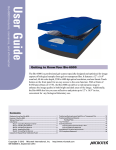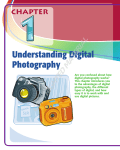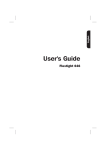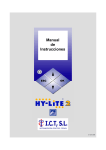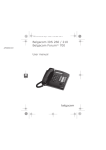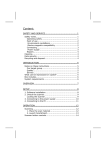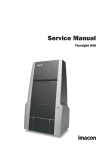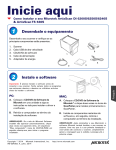Download User Guide
Transcript
User Guide Bio-6000T features, scenarios, and information Getting to Know Your Bio-6000T The Bio-6000T is a professional gel scanner specially designed and optimized for image capture of biological samples from gels or transparent film. It features a 12" x 16.9" scan bed, 48-bit color depth, 3200 x 6400-dpi optical resolution, and one SmartTouch button on the front panel for an easy access to the scan function. With a Dmin of 0.05D and a Dmax of 3.77D, the Bio-6000T can deliver a wide dynamic range to enhance the image quality in both bright and dark areas of the image. Additionally, the Bio-6000T also lets you scan reflectives and prints up to 12" x 16.9" in size, convenient for any biological laboratory use. Contents Getting to KnowYour Bio-6000T .................................................................... 1 Features of the Bio-6000T ................................................................................ 2 Taking a Closer Look ........................................................................................ 3 Initial Setup ...................................................................................................... 4 Step 1: Unpacking Package Contents ................................................... 4 Step 2: Installing the Software .............................................................. 5 Step 3: Unlocking the Scanner .............................................................. 6 Step 4: Installing the TMA ...................................................................... 7 Step 5: Connecting the Scanner ............................................................ 8 Using the U-Shaped Ruler (Calibration Ruler) ............................................... 9 Positioning Electrophoresis Gels/Film or Transparent Film ....................... 11 Copyright © 2013 Microtek International, Inc. I49-004845 D, September 2013 Using the 11 x 11 cm / 24 x 24 cm Leak-Free Glass Holder ................... 11 Using the 12" x 16" Leak-Free Glass Holder ......................................... 12 Positioning Reflective Materials ................................................................... 13 The Black Plate .............................................................................. 14 Your First Scan ............................................................................................... 15 Scanning Scenarios ....................................................................................... 17 Scanning Electrophoresis Gels or Film ................................................ 18 Scanning Reflective Materials ............................................................... 21 Specifications / System Requirements ........................................................ 23 FCC Compliance Statement .......................................................................... 24 http://www.microtek.com Features of the Bio-6000T The Bio-6000T comes with several important features, including the following: 2 • Large 12" x 16.9" scan bed — The tabloid-size scan bed of the Bio-6000T lets you easily scan biological samples from a gel or film up to 12" x 16 1/16" and oversized reflective originals, such as contact sheets, large pieces of art and mechanical blueprints. • 3200 x 6400-dpi resolution: The exceptionally high resolution of the Bio-6000T lets you scan even postage-size images and enlarge them with amazing clarity, with little loss of detail. The scanner’s 3.77 maximum optical density allows it to capture a wide range of tones approximating real-life color and hues. • Smart-Touch button: A Smart-Touch button (Scan) locating at the front panel of the scanner provides you a quick and easy way to capture images that can be automatically saved as files or sent to another application for further processing later. • Energy-saving LED light source: Adopting LEDs as the light source, when the scanner is detected by the system, there are no requirements for any warm-up time before carrying out the scan, which boots your productivity and reduces energy costs amazingly. With its stable performance, the image quality will remain consistent even after used for a certain period of time. • Convenient Leak-Free Glass Holders: These holders are designed to scan electrophoresis gels with Bio-6000T, which can be removed and clean-up easily. Available holder sizes are 11x 11 cm, 24 x 24 cm, and 12” x 16”. Contact your local authorized dealers or Microtek sales for additional information if necessary. • Microtek ScanWizard™ Bio scanning software: This is a scanning software for the use of the electrophoresis gel/film scanning. Friendly and easy-to-use interface with powerful functions and controls offer you a quick access and management for all your scanning tasks. • Microtek's MiBio software: This is a management software developed exclusively for Bio-tech analysis and research. It features several easy-to-use but very practical functions, supporting users with powerful tools in a clear and simple control panel. Bio-6000T User Guide Taking a Closer Look TMA Scanner Glass surface (Scan bed) Vertical ruler READY indicator (Green) POWER indicator (Orange) Smart-Touch button (Scan) Accessory port (or with TMA's connector securely connected) Power connector Hi-Speed USB port (1) Power switch Bio-6000T User Guide 3 Initial Setup Step 1: Unpacking Package Contents After unpacking your scanner package, please check for the major components listed below. 7 4 1 8 2 3 1. 2. 3. 4. 5. 6. 7. 8. 9. 4 Bio-6000T User Guide 5 6 9 Bio-6000T (lower base) USB Cable U-shaped Ruler (Calibration Ruler) - for calibrating your scanner TMA (Transparent Media Adapter) Black Plate - for scanning reflectives Power Cord White Mat - for scanning reflectives Software CDs Leak-Free Glass Holders (11 x 11 cm, 24 x 24 cm, and 12" x 16") Step 2: Installing the Software Important: Do not remove the yellow sticker from your scanner until you are told to do so. You must install software before connecting your scanner. Always close any open programs and turn off Anti-virus utilities before installing software. 1. Place the Adobe CD-ROM into the CDROM drive, and install the software. Skip this step if you have a newer version of Adobe Photoshop Elements already installed on your computer. 2. Place the Microtek software CD-ROM into the CD-ROM drive, then follow the on-screen instructions to install the driver and software. NOTE: If the Microtek Software Installer screen does not come up automatically, doubleclick the following in succession: “My Computer”; the CD-ROM icon; then cdsetup.exe to start the installer program. 3. Restart your computer at the end of all software installation. Drivers & Software Upgrades After you finish the installation of software, if you found that the installed drivers and software cannot run your product or your computer system properly later, please go to the Microtek Download Service site at ww7.microtek.com.tw/service.php to download and install any updates you may require. For additional information about Microtek products, please visit our website at www.microtek.com. Bio-6000T User Guide 5 Step 3: Unlocking the Scanner Before you operate the scanner, you will need to unlock the scanner. To unlock the scanner, follow the steps below: 1. Remove the yellow “Unlock” sticker from your scanner. 2. With the scanner power off, turn the scanner on its side and locate the locking screw at the bottom of the scanner. 3. Using a screwdriver, push and turn the locking screw counterclockwise to the unlock position. Unlocked When successfully unlocked, the screw will push out a little, protruding slightly from the bottom of the scanner. Locking the Scanner To lock the scanner (for shipping and other purposes), follow the steps below: 1. Turn off the scanner. 2. Turn the scanner back on. When the indicators on the front of your scanner stop blinking, use a screwdriver, and then push and turn the locking screw clockwise to the locked position. When the screw has been tightened, this indicates that your scanner is locked. 3. Turn off your scanner. 6 Bio-6000T User Guide Locked Step 4: Installing the TMA 1. Attach the TMA by sliding the posts at the rear of the TMA into the holes. Unlocked 2. Plug the connector of the TMA into the scanner’s 15-pin accessory port. 3. Unlock the TMA. a) Remove the yellow “Unlock” sticker from the TMA. a) Look for the locking knob at the base of the TMA. b) Turn the locking knob counterclockwise to the unlock position “ ”. Locking the TMA To lock the TMA (for shipping and other purposes), follow the steps below: 1. Make sure the TMA is connected to the scanner, then turn off the scanner if your scanner is on. Locked 2. Turn the scanner back on. The TMA's carriage will move to the standby position in a few moments. 3. When the indicators on the front of your TMA and scanner stop blinking, turn the locking knob clockwise to the lock position “ ”. 4. Turn off your scanner and disconnect the TMA connector from the scanner. The TMA is ready for transport. Bio-6000T User Guide 7 Step 5: Connecting the Scanner To the power adapter 1. Connect the power cord to the back of the scanner. 2. Plug the power cord into a power source. To the Hi-Speed USB cable 3. Connect one end of the cable to your computer. 4. Connect the other end of the cable to the scanner. 5. Press the power switch at the back of your scanner, and wait for the indicator light on the front panel to stop blinking and stay on steady. The system will detect your scanner automatically. 8 Bio-6000T User Guide Using the U-shaped Ruler (Calibration Ruler) The U-shaped Ruler (Calibration Ruler) is designed for the use of the scanner calibration. Please take note that before putting the U-shaped Ruler on the scanner glass surface, make sure the scanner is turned off. To use the U-shaped Ruler: 1. Peel the protective film from the back side of the ruler before using it to calibrate the scanner. 2. You may choose either the electrophoresis gel/film or reflective material as a target to calibrate your scanner. • If you using the electrophoresis gels/film as a target to calibrate your scanner, put the U-shaped Ruler facing up on the scan bed and hook the ruler onto the raised Silicone Rings located on the both sides of the scanner surface, making sure that they have been oriented correctly. Silicone Rings U-shaped Ruler Bio-6000T User Guide 9 • If you using the reflective material as a target to calibrate your scanner, you have to put the White Mat on the scanner glass surface first. a) Peel the protective films from the both sides of the White Mat. b) Put the White Mat on the scanner glass surface. Make sure that the White Mat covers the whole scanner glass surface completely. White Mat c) Then, put the U-shaped Ruler facing up on the top of the White Mat and hook the ruler onto the raised Silicone Rings located on the both sides of the scan bed, making sure that they have been oriented correctly. White Mat U-shaped Ruler 3. Finally, turn on the scanner power. 10 Bio-6000T User Guide Positioning Electrophoresis Gels/Film or Transparent Film To scan the electrophoresis gels/film (such as 1D/2D gels, SDS-PAGE, western/ northern/southern blots, or membranes) and transparent film (such as slide, positive film, or reversal film), please use the Leak-Free Glass Holder together. The Leak-Free Glass Holders are designed to scan electrophoresis gels/film or transparent film with Bio-6000T, which are easily removed and cleaned with water. Supported holder sizes are 11 x 11 cm, 24 x 24 cm, and 12” x 16”. 12" x 16" 11 x 11 cm 24 x 24 cm Using the 11 x 11 cm / 24 x 24 cm Leak-Free Glass Holder 1. Place the gel or film to be scanned on the top of the Leak-Free Glass Holder, with the target facing down. 2. Then, place the holder with loaded gel or film on the scanner glass surface, and center the holder along the edge of the scanner glass surface or U-shaped Ruler. Leak-Free Glass Holder Calibration strip Remember to keep the area of the calibration strip clear. Bio-6000T User Guide 11 Using the 12" x 16" Leak-Free Glass Holder 1. Put the holder on the top of the scanner glass surface. Make sure that four corners of the holder have been snapped on the both sides of the scanner tightly and the top edge of the holder has been aligned with the edge of the scanner glass surface. 2. Then, place the gel or film to be scanned on the top of the holder. Make sure the top edge of the target has been aligned with the white lines labeled at the two sides of the holder. 12 Bio-6000T User Guide 12" x 16" Leak-Free Glass Holder Positioning Reflective Materials To scan reflective materials (such as photo, prints, dissertations, papers, etc.), you have to scan the reflective together with the U-shaped Ruler (Calibration Ruler), White Mat, and Black Plate. Before positioning the reflective, make sure that the White Mat and U-shaped Ruler are on the scanner bed properly. 1. Peel the protective films from the both sides of the White Mat. 2. Put the White Mat on the scanner glass surface. Make sure that the White Mat covers the whole scanner glass surface completely. White Mat 3. Next, put the U-shaped Ruler facing up on the top of the White Mat and hook the ruler onto the raised Silicone Rings located on the both sides of the scan bed, making sure that they have been oriented correctly. . U-shaped Ruler 4. Next, place the reflective original to be scanned facing down on the top of the White Mat, with the top end of it toward the front of the scanner. Reflective Bio-6000T User Guide 13 5. Peel the protective film from the Black Plate. 6. Put the Black Plate on the top of the reflective to cover it, with the side of the Black Plate that reads “This side up” facing up. Black Plate The Black Plate Light from the TMA and other ambient light during scanning may result in overexposed images. The Black Plate is designed to work with reflective originals. To ensure correct exposure and optimal image quality during scanning, the Black Mat should be used to shield unwanted light out. Take note of the following before using the Black Plate. 1. The Black Plate may become dirty over time and with prolonged use. To clean the plate, use a white cotton cloth dipped in some water, and gently wipe the plate surface. This ensures that the Black Plate is in optimal condition at all times. 2. A protective film covers the Black Plate during shipping and prevents it from being scratched. When peeling the film from the plate, be careful not to tear or bend the Black Plate. 14 Bio-6000T User Guide Your First Scan This section is to guide you to perform your first scan by using the ScanWizard Bio. You should familiarize yourself with the basic scanning technique before you continue further scanning scenarios described in next pages. 1. Launch ScanWizard Bio either as a stand-alone by clicking on the program icon, or by using the File-Import or File-Acquire command from your image-editing program. 2. Place the Leak-Free Holder with loaded gel or film to be scanned facing down on the scanner glass surface, with the top end of it toward the front of the scanner. U-shaped Ruler NOTE: If using the reflective material as your calibration target, please put the White Mat on the scanner glass surface first, and then put the U-shaped Ruler on the top of the What Mat. Refer to “Using the U-Shaped Ruler” in this guide for details. 3. Go to the Preview window of ScanWizard Bio, and choose Transmissive from the Scan Material menu. 4. Click the Overview button to perform a preliminary scan of the image, which will appear in the Preview window. 5. Select the Scan Frame tool from the Toolbar in the Preview window, and choose the area to be scanned by dragging a rectangle around it. You will see a flashing frame (marquee) around the selected area. 6. Click the Prescan button to display a detailed image of area selected by the Scan Frame tool. A thumbnail of the image appears as well in the Scan Job Queue window. 7. Specify your scanning requirements in the Settings window. a) Select a desired image type. b) Select a desired resolution. c) Adjust the scan frame settings if necessary. Bio-6000T User Guide 15 8. Adjust image quality if necessary, using the Advanced Image Correction (AIC) tools. 9. Click the Scan to (or “Scan”) button in the Preview window or on the scanner unit to start scanning. 16 • If ScanWizard Bio was launched from an application program, the image is then delivered to your application, where the image can be saved, printed, or edited. • If ScanWizard Bio was launched in stand-alone mode, you will be prompted to specify the file attributes for the scanned image after the Scan or Scan to button is pressed, such as entering the file name, specifying a folder name of your own, etc. When you have completed the settings, press the Done/Save button, and the scanner will automatically scan and save your image based on your settings. Bio-6000T User Guide Settings window Preview window Scan Job window Bio-6000T User Guide 17 Scanning Scenarios The following pages provide various scenarios for scanning with the Bio-6000T, including the following: 18 • Scanning electrophoresis gels or film: This scenario details the steps for scanning electrophoresis gels or film. • Scanning reflective originals: This scenario details the steps for scanning reflective materials, such as photos or prints. Bio-6000T User Guide Scanning Electrophoresis Gels or Film 1. Place the Leak-Free Glass Holder with loaded gel or film to be scanned on the scan bed, as detailed in the “Positioning Electrophoresis Gels/Film or Transparent Film” section of this guide. 2. Launch ScanWizard Bio either as a stand-alone by clicking on the program icon, or by using the File-Import or FileAcquire command from your imageediting program. Leak-Free Glass Holder Gel or film Calibration strip 3. Go to the Preview window and choose Transmissive from the Scan Material menu. 4. Click the Overview button to perform a preliminary scan of your original. 5. Select the Scan Frame tool from the Toolbar in the Preview window, and choose the area to be scanned by dragging a rectangle around it. You will see a flashing frame (marquee) around the selected area. 6. Click the Prescan button to display a detailed image area selected via the Scan Frame tool. A thumbnail of the image appears as well in the Scan Job Queue window. 7. Specify your scanning requirements in the Settings window. a) Select a desired image type. b) Select a desired resolution. c) Adjust the scan frame settings if necessary. 8. Adjust image quality if necessary, using the Advanced Image Correction (AIC) tools. 9. Click the Scan to (or “Scan”) button in the Preview window or on the scanner unit to start scanning. • If ScanWizard Bio was launched from an application program, the image is then delivered to your application, where the image can be saved, printed, or edited. • If ScanWizard Bio was launched in stand-alone mode, you will be prompted to specify the file attributes for the scanned image after the Scan or Scan to button is pressed, such as entering the file name, specifying a folder name of your own, etc. When you have completed the settings, press the Done/Save button, and the scanner will automatically scan and save your image based on your settings. Bio-6000T User Guide 19 Settings window Preview window Scan Job window 20 Bio-6000T User Guide Scanning Reflective Materials 1. Place the reflective original to be scanned on the scan bed, as detailed in the “Positioning Reflective Materials” section of this guide. 2. Launch ScanWizard Bio either as a stand-alone by clicking on the program icon, or by using the File-Import or FileAcquire command from your imageediting program. Black Plate Reflective White Mat U-shaped Ruler 3. Go to the Preview window of ScanWizard Bio, and choose Reflective from the Scan Material menu. 4. Click the Overview button to perform a preliminary scan of the image, which will appear in the Preview window. 5. Select the Scan Frame tool from the Toolbar in the Preview window, and choose the area to be scanned by dragging a rectangle around it. You will see a flashing frame (marquee) around the selected area. 6. Click the Prescan button to display a detailed image area selected via the Scan Frame tool. A thumbnail of the image appears as well in the Scan Job Queue window. 7. Specify your scanning requirements in the Settings window. a) Select a desired image type. b) Select a desired resolution. c) Adjust the scan frame settings if necessary. 8. Adjust image quality if necessary, using the Advanced Image Correction (AIC) tools. 9. Click the Scan to (or “Scan”) button in the Preview window or on the scanner unit to start scanning. • If ScanWizard Bio was launched from an application program, the image is then delivered to your application, where the image can be saved, printed, or edited. • If ScanWizard Bio was launched in stand-alone mode, you will be prompted to specify the file attributes for the scanned image after the Scan or Scan to button is pressed, such as entering the file name, specifying a folder name of your own, etc. When you have completed the settings, press the Done/Save button, and the scanner will automatically scan and save your image based on your settings. Bio-6000T User Guide 21 Settings window Preview window Scan Job window 22 Bio-6000T User Guide Specifications Scanning Modes Light Source Scanning Area Resolution Dynamic Range Interface Dimensions (L x W x H) Weight Voltage Power Consumption Environment Color and grayscale in a single scanning pass True 48-bit color (approx. 281 billion colors) 16-bit grayscale (approx. 65,536 shades of gray) LED Reflective: 12" x 16.9" (304.8 mm x 429.26 mm) Transparent: 12" x 16 1/16" (304.8 mm x 408 mm) Optical: 3200 (H) dpi x 6400 (V) dpi Transparency: 0.05D ~ 3.77D, 3.77 Dmax Hi-Speed USB (USB 2.0) 24.7" x 14.8" x 7.3" ( 627 mm x 375 mm x 185 mm) 35.4 lbs (16.1 kg) AC 100V-240V, 47-63 Hz, 1.5 A max. 54.9 W max. Operating Temperature: 50° F to 104° F (10° C to 40° C) Relative Humidity: 20% to 85% System Requirements General Requirements • CD-ROM drive (for installing software) • Color display with 24-bit color output capability • 512 MB RAM or more PC and compatibles • Pentium IV PC or higher with Hi-Speed USB (USB 2.0) port • Microsoft Windows 7; compatible with Windows XP, Vista and Windows 8 Important Specifications, software bundles, and accessories are subject to change without notice. Not responsible for typographic errors. Bio-6000T User Guide 23 FCC Compliance Statement This equipment (Model: MRS-6400A3PL) has been tested and found to comply with the limits for a Class B digital device, pursuant to Part 15 of the FCC rules. These limits are designed to provide reasonable protection against harmful interference in a residential installation. This equipment generates, uses and can radiate radio frequency energy and, if not installed and used in accordance with the instructions, may cause harmful interference to radio communications. However, there is no guarantee that interference will not occur in a particular installation. If this equipment does cause harmful interference to radio or television reception, which can be determined by turning the equipment off and on, the user is encouraged to try to correct the interference by one or more of the following measures: • Reorient or relocate the receiving antenna. • Increase the separation between the equipment and receiver. • Connect the equipment into an outlet on a circuit different from that to which the receiver is connected. • Consult the dealer or an experienced radio/TV technician for help. NOTE: A shielded Hi-Speed USB interface cable with ferrite core installed on the scanner connector and must be used with this equipment. Caution: Changes or modifications not expressly approved by the manufacturer responsible for compliance could void the user's authority to operate the equipment. This device complies with Part 15 of the FCC Rules. Operation is subject to the following two conditions: (1) This device may not cause harmful interference, and (2) this device must accept any interference received, including interference that may cause undesired operation. 24 Bio-6000T User Guide
























